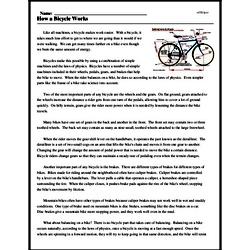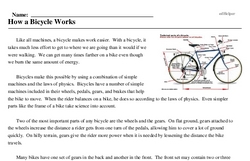How a Bicycle Works
Like all machines, a bicycle makes work easier. With a bicycle, it takes much less effort to get to where we are going than it would if we were walking. We can get many times farther on a bike even though we burn the same amount of energy.
Bicycles make this possible by using a combination of simple machines and the laws of physics. Bicycles have a number of simple machines included in their wheels, pedals, gears, and brakes that help the bike to move. When the rider balances on a bike, he does so according to the laws of physics. Even simpler parts like the frame of a bike take science into account.
Two of the most important parts of any bicycle are the wheels and the gears. On flat ground, gears attached to the wheels increase the distance a rider gets from one turn of the pedals, allowing him to cover a lot of ground quickly. On hilly terrain, gears give the rider more power when it is needed by lessening the distance the bike travels.




